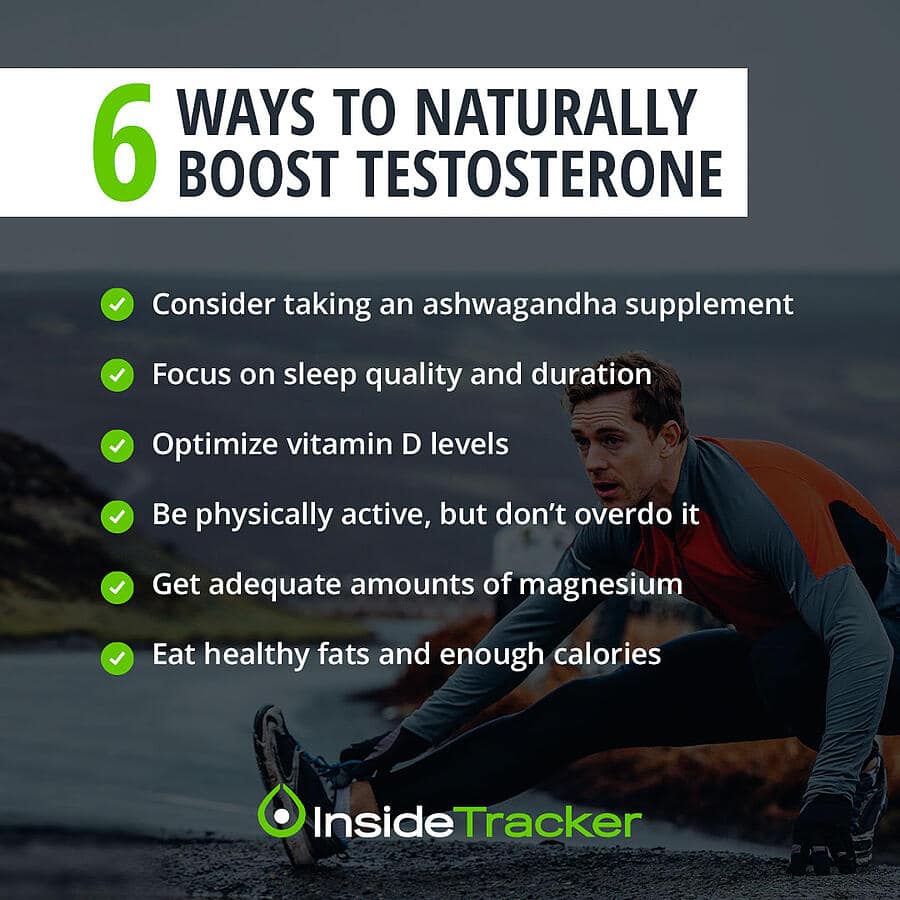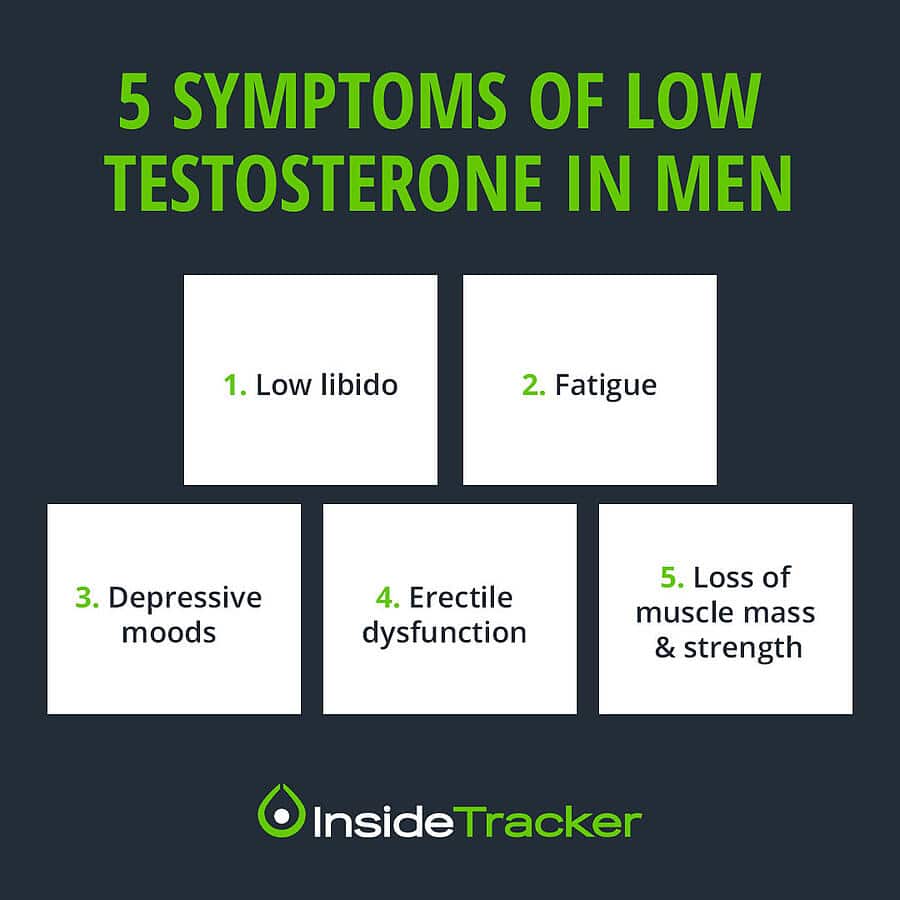Testosterone is the main male sex hormone that plays an integral role in growth and development, cognitive and sexual function, and healthy aging throughout a man’s life. [1] Testosterone levels drop around 1%-2% each year after age 40. [2] Certain dietary and lifestyle practices can help naturally increase testosterone, promoting healthy aging and enhancing performance.

How testosterone is measured
Testosterone is an anabolic hormone that is responsible for helping to regulate puberty, sperm production, sex drive, bone health, muscle mass, strength, and even red blood cell production and hemoglobin concentrations. [1] And these processes run smoothly when there is a balance between bound and free testosterone. Bound testosterone means that the hormone is attached to a protein like albumin or sex hormone-binding globulin (SHBG). Most testosterone in the blood, around 97-98%, is bound. [3] However, this type of testosterone is biologically inactive. Free testosterone, however, is the form responsible for regulating testosterone-specific actions in the body, despite its relatively minuscule concentration compared to its bound counterpart. Total testosterone is a combination of the two.
The low end of the normal range for total testosterone is between 250-300 ng/dL and the upper end is 1,000-1,100 ng/dL. [1] But just because something’s normal, doesn’t mean it’s optimized. Testosterone can still be low within this normal range.
The impact of low testosterone on men’s health
Low testosterone can impact physical performance and quality of life. Symptoms of low testosterone include low libido, fatigue, depressive moods, erectile dysfunction, and loss of muscle mass. [4] Whether your goal is to build muscle, promote healthy aging, or improve overall health, here are six ways to naturally boost testosterone.
1. Consider taking an ashwagandha supplement
Ashwagandha is an herb derived from the roots of the Withania somnifera plant. It’s an integral component of Ayurvedic medicine and can now commonly be found as a supplement. Ashwagandha is most known for its ability to reduce stress, but it can also help boost testosterone levels in men.
One randomized controlled trial of 57 males with little experience in resistance training showed that daily supplementation of 600 mg of Ashwagandha for eight weeks significantly increased testosterone levels compared to a placebo. [5] These men also had markedly improved measures of muscle strength compared to the placebo at the end of the study. A smaller study of 46 males with low sperm counts took 675 mg a day for three months. Blood testosterone levels increased 17% compared to the beginning of the study, and sperm count also increased. [6] Another study found a nearly 15% greater increase in testosterone levels after 16 weeks of ashwagandha supplementation compared to placebo. [2] Interestingly, however, a study that included women found that ashwagandha didn’t impact testosterone levels. [7]
Ashwagandha supplements can be an effective remedy for men with low testosterone levels. It’s best to get a blood test to determine your free and total testosterone levels before beginning an ashwagandha supplement regimen.
2. Focus on sleep quality and duration
Sleep quality and duration can impact testosterone. Too much or too little sleep is associated with lower testosterone, whereas adequate sleep duration is associated with improved testosterone levels. A 2015 study including 1,274 men aged 65 and older showed that up to almost 10 hours of sleep correlated with increased testosterone. [8] One small study of 10 men found that even just short-term sleep deprivation (one week of sleeping only five hours per night) significantly reduced testosterone. [9] This sleep restriction also increased the stress hormone cortisol and induced low energy and libido.
Aim to get at least seven to nine hours of sleep per night. If sleep declines during a busy work week, catch-up sleep on the weekends can improve testosterone levels. [10] Magnesium or melatonin supplements and bedroom temperature, humidity, and light can all influence sleep. Find out more hacks for getting a restful night’s sleep without changing your bedtime in this blog.
3. Optimize vitamin D levels
Vitamin D is most known for its role in bone health, but there are vitamin D receptors throughout the body — including in reproductive tissue. For middle-aged men, low vitamin D has been linked to low testosterone. [11] And a large study of 1,362 men found that higher vitamin D levels in the blood were positively correlated with higher testosterone levels. [12] Vitamin D supplementation can even boost testosterone in people who are deficient in the vitamin. A year-long trial of both men and women found that daily supplementation of just over 3,000 IU per day significantly increased total testosterone and free testosterone (and corrected the vitamin D deficiency). [13]
Before beginning a high-dose vitamin D supplement to improve testosterone, it’s best to know where both of those values stand as, if neither are low or deficient, this supplementation may not be a beneficial intervention. Check out this article for more information on testosterone and vitamin D.
4. Be physically active, but don’t overdo it
Men who are physically active have a better testosterone profile compared to more sedentary men. [14,15] For people who aren’t already physically active, introducing weight or resistance training can improve testosterone levels. [16] However, too much exercise without sufficient recovery can actually lower testosterone levels in what’s called overtraining syndrome. Overtraining is a result of the combination of excessive exercise with inadequate rest and recovery. [17] It impacts hormonal health like testosterone, as well as mental health, immune health, and mood. Overtraining can also lead to sleep issues, further contributing to low testosterone.
Low testosterone and high creatine kinase (an enzyme found in muscles) levels can indicate overtraining syndrome. Read more about that overtraining syndrome and creatine kinase in these articles.

5. Take in adequate amounts of magnesium
Magnesium is an essential mineral that positively influences testosterone levels in men. [18] And many adults don’t meet the recommended daily intake for magnesium (found in foods like pumpkin seeds, spinach, and black beans), which is 420 mg for men and 320 mg for women. This is reflected in InsideTracker users — in fact, our data shows that 20% of male and 28% of female InsideTracker users have below-optimized magnesium levels.
Magnesium plays an important role in muscle function and appears to interact with testosterone in the body. [18,19] Research shows that magnesium supplementation paired with resistance exercise may increase testosterone production in men. [18,20] But, similar to the vitamin D recommendation, magnesium supplementation may only be beneficial for men who have low levels of both magnesium and testosterone.
6. Eat healthy fats and enough calories
Eating a low-fat diet and dieting/restricting calorie intake/underfueling can all lower testosterone levels. A 2021 systematic review and meta-analysis of nine studies totaling 206 participants found that low-fat diets appear to significantly decrease testosterone levels in men. [21] Interestingly, this decrease was more profound in men with European ancestry. Healthy fats like those found in olive oil, avocados, nuts, and seeds are essential for supporting hormone health.
Sufficient dietary fat helps meet the body’s calorie needs. Calorie restriction was shown to reduce sex hormones, including testosterone, in healthy lean men. [22]. Physically active men (especially in weight class sports) are at risk for low energy availability, meaning they don’t consume enough calories to support what they burn and what their body needs to function. This is also associated with reduced testosterone levels. [23]
If your testosterone is below optimal but your vitamin D and magnesium are optimal, consider whether a lack of healthy fats or general underfueling may be to blame. If you’re unsure of whether you’re fueling your activity/sport properly, work with a sports dietitian to ensure you’re meeting your calorie and nutrient needs.

Summary
Optimal testosterone levels in men is an integral component to promote healthy aging, muscle growth, and sexual and cognitive function in men. And it is possible to naturally increase testosterone levels through dietary and lifestyle adjustments. But first, you need to know where your testosterone levels currently stand. An InsideTracker plan will tell you whether or not your testosterone levels (total testosterone and free testosterone) and SHBG are optimized and provide more personalized recommendations on how to improve them.
AGEIST readers save 25% on all InsideTracker products here.

Molly Knudsen, MS, RDN is a Team Nutritionist at InsideTracker. As a Registered Dietitian, Molly enjoys connecting people to the food they eat and how it influences their biomarkers. When she’s not writing about the latest nutrition science, she’s likely in the middle of a yoga flow or at the beach with a good book.
References:
[1] https://www.ncbi.nlm.nih.gov/pubmed/32082255
[2] https://pubmed.ncbi.nlm.nih.gov/30854916/
[3] https://pubmed.ncbi.nlm.nih.gov/14636872/
[4] https://www.ncbi.nlm.nih.gov/pubmed/25879005
[5] https://www.ncbi.nlm.nih.gov/pubmed/25879005
[6] https://pubmed.ncbi.nlm.nih.gov/24371462/
[7] https://pubmed.ncbi.nlm.nih.gov/31517876/
[8] https://pubmed.ncbi.nlm.nih.gov/25959075/
[9] https://www.ncbi.nlm.nih.gov/pubmed/21632481
[10] https://pubmed.ncbi.nlm.nih.gov/25683266/
[11] https://pubmed.ncbi.nlm.nih.gov/25532570/
[12] https://pubmed.ncbi.nlm.nih.gov/22220644/
[13] https://pubmed.ncbi.nlm.nih.gov/21154195/
[14] https://pubmed.ncbi.nlm.nih.gov/22234399/
[15] https://pubmed.ncbi.nlm.nih.gov/15204068/
[16] https://pubmed.ncbi.nlm.nih.gov/9660159/
[17] https://www.ncbi.nlm.nih.gov/pubmed/23016079
[18] https://www.ncbi.nlm.nih.gov/pubmed/24723948
[19] https://pubmed.ncbi.nlm.nih.gov/21675994/
[20] https://pubmed.ncbi.nlm.nih.gov/20352370/
[21] https://pubmed.ncbi.nlm.nih.gov/33741447/
[22] https://www.ncbi.nlm.nih.gov/pubmed/20096034
[23] https://onlinelibrary.wiley.com/doi/abs/10.1002/tsm2.140





